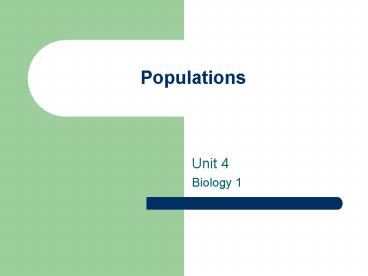Populations - PowerPoint PPT Presentation
1 / 18
Title:
Populations
Description:
Populations Unit 4 Biology 1 Characteristics of Populations Three characteristics are geographic distribution, density, and growth rate Population density the ... – PowerPoint PPT presentation
Number of Views:194
Avg rating:3.0/5.0
Title: Populations
1
Populations
- Unit 4
- Biology 1
2
Characteristics of Populations
- Three characteristics are geographic
distribution, density, and growth rate - Population density the number of individuals
per unit area
3
Populations
- Population growth leads to an increase in food,
energy and other resource consumption - Carrying capacity is the maximum population a
given environment can reasonably sustain
4
Population Growth
- Three factors can affect population size
- Number of deaths
- Number of births
- Number of individuals that enter or leave the
population
5
Population Growth
- Immigration movement of individuals into an area
- Emigration the movement of individuals out of a
population
6
Exponential Growth
- Occurs when the individuals in a population
reproduce at a constant rate - Characterized by doubling
- Starts slowly, but rapidly increases
- Total growth in one doubling is more than the
total of all preceding growth - Exponential growth occurs when the rate of growth
is directly proportional to the number present - ?N/?t N
7
Exponential Growth
- Doubling time equation is
- Doubling time 70/ of annual growth (r)
- So if the annual growth rate is 2 then 70/235
years to double the population
8
Limiting Factors
- A limiting factor causes the population growth to
decrease. - Two types
- Density-dependent factors
- Density-indepentent factors
9
Density-Dependent Factors
- A limiting factor that depends of a population
size - Include competition, predation, parasitism and
disease
10
Density-Dependent Factors
- Competition when populations become crowded
organisms compete for food, water, space,
sunlight and other essentials - Niche role of an organism
11
Density-Dependent Factors
- Predation
- Predator-prey relationship
- Parasitism and disease
- Similar to predators, but with microscopic
organisms
12
Density-Independent Factors
- Affects all population regardless of population
size - Include natural disasters, seasonal cycles, human
activities
13
Human Population
- In the beginning of history the world population
has changed very little because the death rate
and birth rate were relatively equal - However, recently the birth rate began to out
number the death rater? - Why?
14
Human Population
15
Human Populations
- Changes in population size are recorded and
monitored by demographers - Demographers use the numerical equation to
express changes in the population - Population growth Birth rate death rate
- This does not take into consideration immigration
and emigration
16
Human Populations
17
Age-Structure Diagrams
18
Future of Human Population Growth
- It is predicted that the worlds population will
stabilize at 10.2 billion by 2100 and the
replacement level of 2 children per couple will
be reached by 2035 - However, some say the population will not
stabilize until 11.2 billion - How did they come up with this data?
- Declining importance of children needed for labor
- Increased cost of raising children
- Improved social status of women
- Rising education level and improved employment

